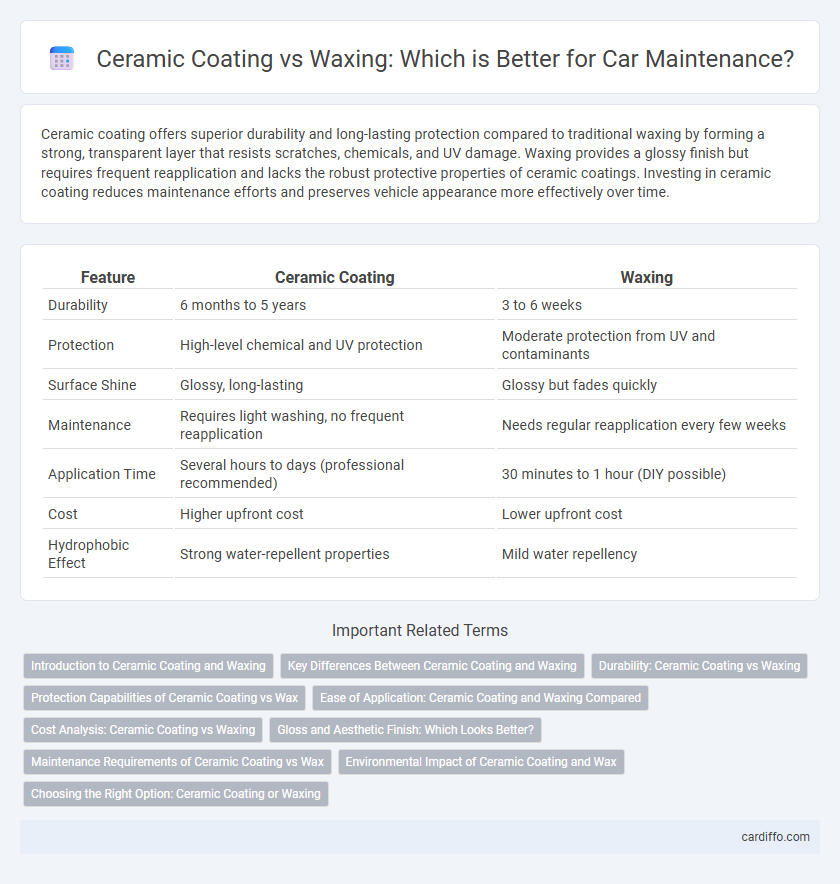Ceramic coating offers superior durability and long-lasting protection compared to traditional waxing by forming a strong, transparent layer that resists scratches, chemicals, and UV damage. Waxing provides a glossy finish but requires frequent reapplication and lacks the robust protective properties of ceramic coatings. Investing in ceramic coating reduces maintenance efforts and preserves vehicle appearance more effectively over time.
Table of Comparison
| Feature | Ceramic Coating | Waxing |
|---|---|---|
| Durability | 6 months to 5 years | 3 to 6 weeks |
| Protection | High-level chemical and UV protection | Moderate protection from UV and contaminants |
| Surface Shine | Glossy, long-lasting | Glossy but fades quickly |
| Maintenance | Requires light washing, no frequent reapplication | Needs regular reapplication every few weeks |
| Application Time | Several hours to days (professional recommended) | 30 minutes to 1 hour (DIY possible) |
| Cost | Higher upfront cost | Lower upfront cost |
| Hydrophobic Effect | Strong water-repellent properties | Mild water repellency |
Introduction to Ceramic Coating and Waxing
Ceramic coating is a liquid polymer applied to a vehicle's exterior that chemically bonds with the factory paint, creating a durable, protective layer resistant to scratches, chemicals, and UV damage. Waxing involves applying a natural or synthetic substance that forms a thin, sacrificial layer on the surface, enhancing gloss and repelling water but requiring frequent reapplication. Compared to waxing, ceramic coatings offer longer-lasting protection and superior hydrophobic properties, making them a preferred choice for long-term vehicle maintenance.
Key Differences Between Ceramic Coating and Waxing
Ceramic coating provides long-lasting protection by forming a durable, transparent layer that resists UV rays, chemicals, and minor scratches, unlike waxing which offers temporary surface protection lasting a few weeks. The hydrophobic properties of ceramic coatings enhance water repellency and ease of cleaning, whereas wax requires frequent reapplication to maintain similar effects. Cost and application time differ significantly, with ceramic coatings being more expensive and requiring professional installation, while waxing is more affordable and can be performed DIY.
Durability: Ceramic Coating vs Waxing
Ceramic coating offers superior durability compared to waxing, with protection lasting up to five years versus waxing's typical 2-3 month coverage. Its advanced nano-ceramic technology creates a hard, hydrophobic surface that resists scratches, UV damage, and chemical contaminants more effectively than traditional wax. This long-lasting barrier reduces the frequency of maintenance, making ceramic coating a cost-effective solution for vehicle protection.
Protection Capabilities of Ceramic Coating vs Wax
Ceramic coating provides superior protection compared to traditional wax by forming a durable, semi-permanent layer that resists UV rays, chemicals, and minor scratches, extending the lifespan of a vehicle's paint. Wax creates a protective barrier that can enhance shine and repel water but typically lasts only a few weeks to months, requiring frequent reapplication. The advanced nanotechnology in ceramic coatings offers long-lasting hydrophobic properties and enhanced resistance against environmental contaminants, making it the preferred choice for long-term vehicle maintenance.
Ease of Application: Ceramic Coating and Waxing Compared
Ceramic coating offers a longer-lasting protective layer but requires professional application or careful preparation and curing time, making it less user-friendly for novices. Waxing is simpler to apply and can be done at home with minimal tools, but it demands more frequent reapplication due to its shorter lifespan. The choice between ceramic coating and waxing depends on whether ease of application or durability is the priority in vehicle maintenance.
Cost Analysis: Ceramic Coating vs Waxing
Ceramic coating typically ranges from $500 to $2,000 upfront, offering long-term durability lasting 2 to 5 years, which significantly reduces recurring maintenance expenses. Waxing costs between $50 and $150 per application but requires reapplication every 1 to 3 months, accumulating higher annual costs. When analyzing cost-effectiveness, ceramic coating provides a more economical solution over time despite the higher initial investment due to its prolonged protection and reduced need for frequent treatments.
Gloss and Aesthetic Finish: Which Looks Better?
Ceramic coating provides a deeper, more durable gloss compared to traditional waxing, maintaining a high-shine finish for months due to its advanced silica-based formula. Waxing offers a warm, rich gloss initially but fades quickly under UV exposure and environmental contaminants. For long-lasting aesthetic appeal, ceramic coating consistently delivers a superior, mirror-like finish that resists oxidation and water spots better than waxing.
Maintenance Requirements of Ceramic Coating vs Wax
Ceramic coating requires minimal maintenance, typically involving regular washing with pH-neutral car soap to preserve its hydrophobic properties and durability, lasting up to five years. Waxing demands more frequent upkeep, usually every few months, as it wears off quickly and exposes the paint to contaminants and UV damage. The enhanced chemical resistance and longevity of ceramic coatings reduce the need for repetitive application compared to traditional wax.
Environmental Impact of Ceramic Coating and Wax
Ceramic coating offers a longer-lasting protective layer that reduces the frequency of washing and waxing, thereby minimizing water usage and chemical runoff into the environment. Waxing often requires repeated applications and contains petrochemicals that can contribute to air and water pollution. Choosing ceramic coating can significantly lower the ecological footprint associated with vehicle maintenance by decreasing the demand for harmful substances and conserving resources.
Choosing the Right Option: Ceramic Coating or Waxing
Ceramic coating offers long-lasting protection by creating a durable, chemical-resistant layer that repels dirt, water, and UV damage, making it ideal for those seeking low-maintenance care. Waxing provides a cost-effective, shorter-term shield that enhances shine and smoothness but requires frequent reapplication to maintain its benefits. Selecting between ceramic coating and waxing depends on factors such as budget, desired durability, and the level of maintenance one is willing to commit to for vehicle protection.
Ceramic coating vs waxing Infographic

 cardiffo.com
cardiffo.com